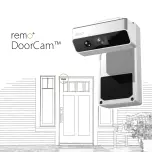
Camera menu (OSD menu) operation
When this button is pressed, the buttons for performing the camera
menu operations are displayed on the screen.
At the same time, the camera menus are displayed on the unit’s
images.
The unit’s camera menu operations can be performed by
pressing the
,
,
and
buttons.
When any of these buttons is pressed to switch to an
operation that does not involve a camera menu, the camera
menus are no longer displayed on the unit’s images.
For details of the camera menu, refer to (→ page 60).
Tally lamp lighting status displays
The lighting status of the camera’s tally lamp is monitored at regular
intervals while the camera is connected, and the lamp’s display is
updated.
While the tally lamp is on, the IP video display area frame turns red.
When the tally lamp is off, the display area will return to normal.
<NOTE>
• It may take 2 seconds or so for a change in the lighting status of the
tally lamp to be reflected on the display of the mobile terminal.
• When [Disable] is selected for [Tally] (→page 56, page 85), the
camera’s tally lamp will not light even when the tally signal is input.
However, the tally lamp lighting status display will turn red.
<NOTE>
• If the HTTP port number has been changed from “80”, enter “http://<IP
address>:<port number>/mobile”
*
1
to specify the unit’s port number.
• When [HTTPS] - [Connection] (→ page 93) is set to [HTTPS] in the
[Advanced] tab of the Network setup screen [Network], enter the
following.
https://<IP address port number>/mobile
• When the authentication dialog box appears, enter the user name and
password of an administrator or general user.
Depending on the mobile terminal, password entry may be required
when transitioning between each screen.
• Audio cannot be received on mobile terminals.
• If the [User auth.] (→ page 87) setting has been changed to [On] from
a personal computer while the mobile terminal screen is displayed, it
may not be possible to refresh the mobile terminal screen. In a case
like this, first close the web browser which is running on the mobile
terminal, and then open the mobile terminal screen again.
• If the images are large, it may not be possible to display them on some
mobile terminals. In a case like this, it may be possible to display the
images if a setting close to low image quality is selected for [Image
quality] (→ page 73) of the [JPEG] among the “Video over IP”.
• Access may not be possible depending on your mobile terminal and
device plans.
• If, when using an Android terminal, more than one button is pressed
at the same time, one of the buttons may remain pressed even after it
has been released. At a time like this, press again only that button that
has remained pressed to release it.
Example) When the pan (left) button and pan (right) button are
pressed at the same time, either the pan (left) button or
pan (right) button will remain pressed, and panning will
continue.
→ When the pan (left) button or pan (right) button that has
remained pressed is pressed again, the panning will
stop.
*
1
This IP address is the global IP address for the WAN of the router
that enables internet access.
However, it is the local IP address if the unit in the same LAN is
to be accessed using a mobile terminal which supports a wireless
connection.
106
107
Displaying the web screen using a mobile terminal (continued)
















































